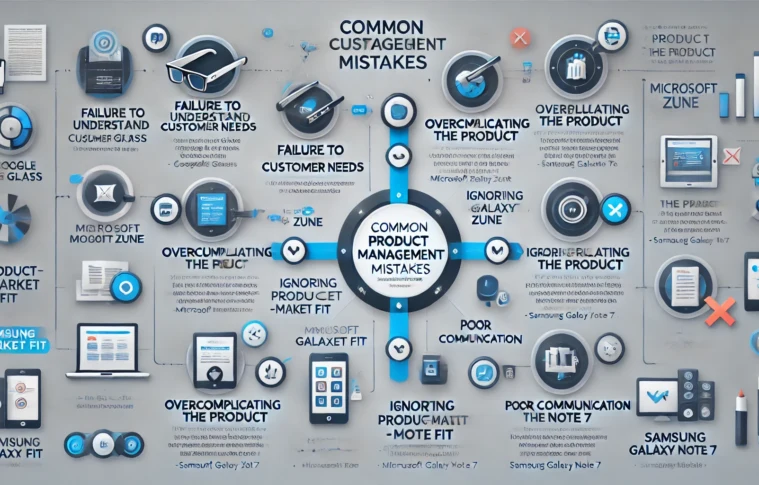Introduction
Product management is a critical function in any organization, but even the most experienced product managers can make mistakes. These missteps can impact product quality, customer satisfaction, and business outcomes. In this case study, we will explore common mistakes that product managers make, using real-world examples to illustrate how to avoid these pitfalls.
Mistake #1: Failing to Understand the Customer’s Needs
Example: Google Glass (2013)
When Google launched Google Glass, the product generated a lot of excitement due to its innovative concept of wearable technology. However, it faced a major failure because Google misunderstood the target market’s actual needs. Google Glass was marketed as a revolutionary product, but it failed to address the practical, day-to-day problems consumers face, such as privacy concerns and a lack of clear use cases.
- Key Mistake: Google failed to conduct enough user research to understand the true needs and desires of the market.
- Lesson: Understand customer needs before developing a product. It is essential to conduct user research, interviews, and usability testing to identify genuine pain points and tailor solutions accordingly.
Mistake #2: Overcomplicating the Product
Example: Microsoft Zune (2006)
Microsoft’s Zune was launched as a competitor to the iPod, offering a variety of features like wireless syncing and subscription services. However, the Zune was overcomplicated for the average user, with features that did not resonate with the market. Apple’s iPod, in contrast, offered a simple, user-friendly experience that customers loved.
- Key Mistake: The Zune’s complexity and feature overload led to confusion among users, and it didn’t differentiate itself enough to outweigh the iPod’s simplicity and brand loyalty.
- Lesson: Avoid overloading your product with unnecessary features. A product that is easy to use and solves a specific problem can be more successful than one that offers everything but fails at solving a core issue.
Mistake #3: Ignoring the Product-Market Fit
Example: Juicero (2016)
The Juicero juicer was a high-tech device that squeezed juice from pre-packaged bags. At first glance, it seemed like a breakthrough product, but the issue was that users could squeeze the juice from the bags manually with their hands, making the machine redundant. Despite the high price and fancy technology, it didn’t actually offer a product-market fit.
- Key Mistake: Juicero ignored the core principle of product-market fit. The product was overly complex and didn’t align with the needs of the target market.
- Lesson: Ensure there is a strong product-market fit before launching. A product must solve an actual problem that people are willing to pay for, and it must provide clear value.
Mistake #4: Poor Communication Between Teams
Example: Samsung Galaxy Note 7 (2016)
Samsung’s Galaxy Note 7 was one of the company’s most anticipated releases. However, a lack of proper communication between teams led to a disastrous product launch. The phone was plagued with battery issues that led to overheating and fires, ultimately resulting in a global recall.
- Key Mistake: A failure in the cross-functional communication process, especially between product development, quality assurance, and supply chain management, caused the product to fail.
- Lesson: Communication between teams is critical. Ensuring product development, engineering, marketing, and customer support teams are aligned can prevent major failures and create a smoother product launch process.
Mistake #5: Focusing Too Much on Technology Instead of User Experience
Example: The Amazon Fire Phone (2014)
Amazon’s Fire Phone was a major flop, despite being heavily hyped before its release. The phone featured innovative technology such as 3D scanning and dynamic perspective, but Amazon neglected to focus on the core needs of users—good usability, performance, and value for money. The Fire Phone lacked essential features like access to Google apps and wasn’t competitive in terms of design and user experience.
- Key Mistake: Amazon focused too much on technological innovation and forgot the most important aspect: user experience.
- Lesson: While technology is important, the user experience should always be the top priority. Build a product that resonates with users on an emotional level and addresses their core needs.
Mistake #6: Not Iterating and Adapting the Product Post-Launch
Example: Snapchat Spectacles (2016)
Snapchat launched Spectacles, a pair of sunglasses that allowed users to record videos and upload them directly to Snapchat. However, despite early excitement, the product quickly flopped because it failed to iterate on user feedback and adapt to the market. The product was bulky, and its appeal was limited, as users didn’t see long-term value in the wearable.
- Key Mistake: Snapchat failed to effectively iterate on the product based on customer feedback, leading to weak sales and a surplus of unsold units.
- Lesson: Post-launch iteration is crucial. Continuously gather feedback from users and be prepared to make adjustments to improve the product over time. An effective product management strategy should include continuous learning and improvement.
Mistake #7: Ignoring Competition
Example: Kodak’s Failure to Transition to Digital
Kodak once dominated the film photography market, but the company failed to adapt to the digital revolution. Although Kodak invented the first digital camera, it didn’t act on this innovation quickly enough and clung to its traditional film business. As competitors embraced digital photography, Kodak lost its market share.
- Key Mistake: Kodak ignored the impending shift in the market and failed to act on early digital innovations.
- Lesson: Keep a close eye on competitors and market trends. Failing to innovate and adapt in a rapidly changing environment can lead to obsolescence.
Conclusion and Key Takeaways
Product management is a complex discipline, and even the best product managers can make mistakes. However, learning from these failures is key to improving product strategies and driving success. The key lessons from the mistakes explored in this case study include:
- Always prioritize customer needs and conduct user research.
- Keep the product simple and avoid feature overload.
- Ensure strong product-market fit before launch.
- Maintain clear communication across teams.
- Focus on user experience, not just technology.
- Iterate and adapt based on post-launch feedback.
- Stay aware of market trends and competitors.
By avoiding these common mistakes, product managers can increase their chances of creating successful, market-leading products.



